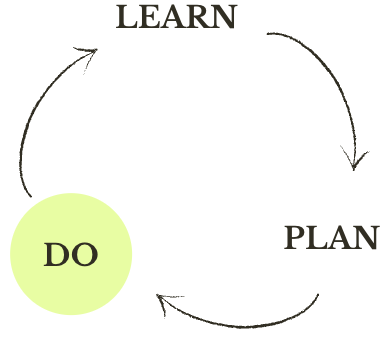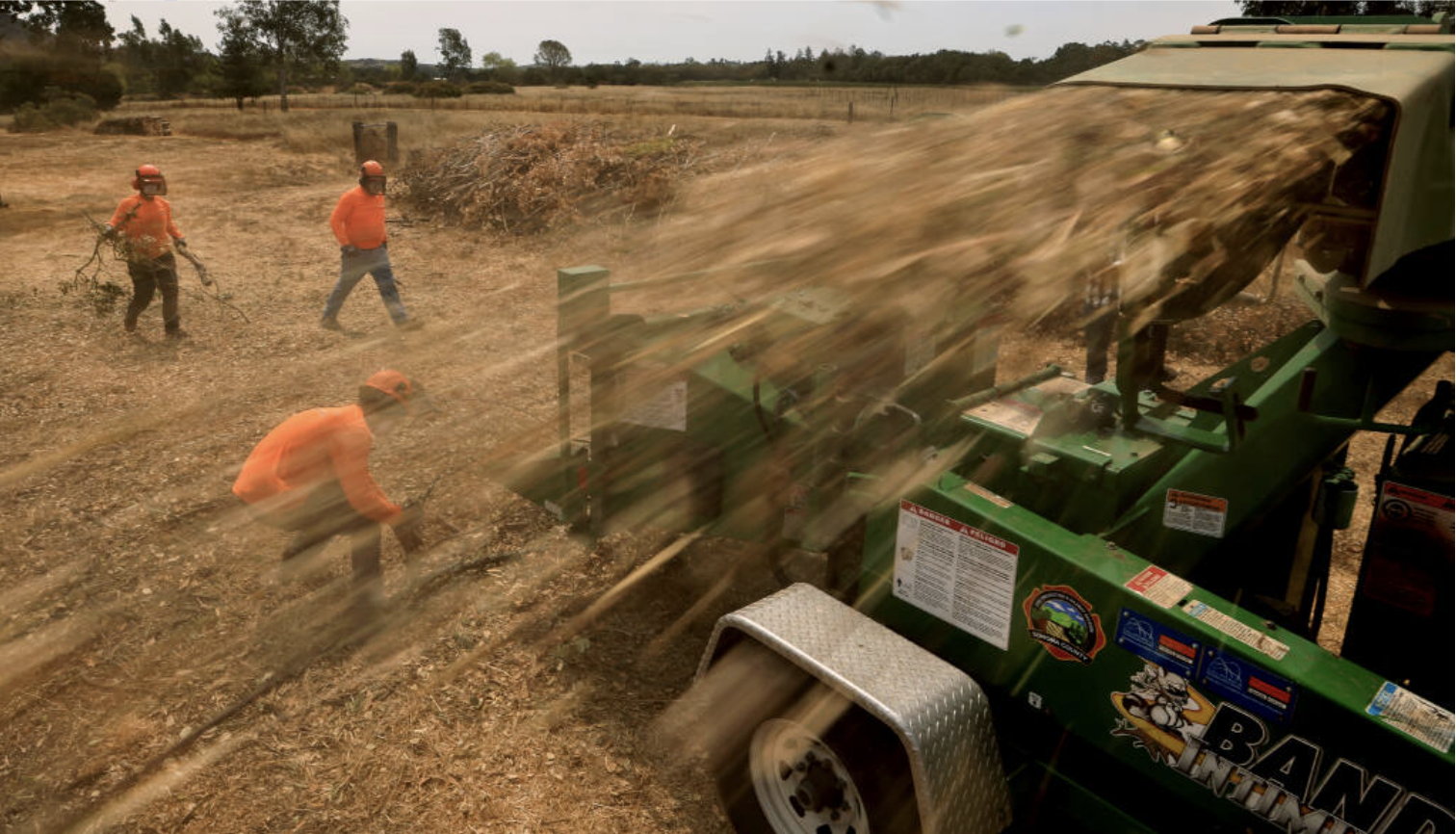DO THE WORK
Wood Chipping
Wood chipping is the use of machinery to cut woody materials into small pieces or chips which allows for a consistently-sized material that is easier to move.


Benefits
Wood Chipping:
- Can reduce wildfire severity by moving flammable material to the ground; note that chipping does not reduce the amount of burnable material unless the chips are buried
- Like other methods for Managing Woody Material, can provide safer travel along roads for firefighters and residents
- If placed on open soils in a thin layer just thick enough to cover the soil from view, can reduce the impact of heavy rain on the soil and help mitigate soil erosion.
When & Where to Wood Chip
- Chipping requires that a truck towing a chipper can be brought to the woody material to be chipped. You will need a relatively flat, even, compact surface. This could be in the defensible space around structures, in a shaded fuel break, or along roads.
- Chipping also requires an area to pile or disperse the chips where they will not cause harm, such as:
- Crushing or smothering desirable vegetation
- Carrying a future fire to trees, or allow a fire to smolder for a long time (this is particularly damaging for trees like oaks which have shallow root systems that extend up to one and a half times beyond their canopies)
- Increasing the risk of ignition around structures
- Chipping is often most effective in combination with other strategies. Review your options in Managing Woody Material.
- Chipping produces greenhouse emissions from both the truck and chipper, from potentially hauling chips away, and from the rapid decomposition of the chipped material. If reducing your contribution to climate change is a priority, consider other options.
Key Points Before Proceeding
Before chipping, other material disposition practices should also be considered.
- Creating firewood for personal use can help reduce the amount of chipping and time needed to manage the flammable materials.
- If carbon sequestration is an objective, Making Biochar or conservation Pile Burning might be better options since small chips create a faster loss of carbon to the atmosphere.
- If Beneficial Fire is planned, it is best to avoid placing wood chips on the site.
Before beginning, consider the ultimate destination for the chipped material. Estimate the volume of chips you can use or disperse, and make a plan for any excess.
In Sonoma County there are several chipping resources. The Sonoma County Chipper Program (email Chipper@sonoma-county.org) offers free use of a chipper during the drier months of the year, though you must fill out an application and meet their guidelines. An increasing number of local fire districts and fire safe councils also have chippers you can use for free or discounted rates.
Chippers come in various sizes. A chipper’s size rating is the maximum diameter material it will chip, although in practice the actual capacity is usually smaller than the rating.
- Three inch chippers are often used for small limbs and materials between one and three inches. These chippers can be moved manually or towed by a lawn mower.
- Six inch chippers need a UTV or truck to move, and can handle most projects concerned with ladder fuels.
- Nine to 12 inch chippers are used by most arborists and tree companies. They will chip most woody materials created from limbing and defensible space work. While they can be rented, they often require a large truck to move, and operating them poses considerable safety risk. It is highly recommended to hire someone to operate a chipper of this size.
- 18 inch chippers are the largest size, used by professionals to chip entire trees. Consider making firewood or other useful items instead of chipping larger diameter wood.
How to Chip Wood
Safety first! Chippers are powerful, dangerous machines.
- Use all safety precautions associated with the chipper you’re using. The CDC lists several injury prevention strategies.
- Any mechanized equipment can ignite fires. Operate the chipper only during cool weather such as mornings, and avoid dry, hot conditions.
Steps:
- Before chipping, make a plan: take stock of which materials you want to chip and how they can be accessed by the chipper; determine where the chipper will be set up, the easiest route to the materials, and have a plan for the finished chipped material.
- Sorting and arranging the material before starting the chipper is critical. Preparation makes chipping more efficient, reduces the risk of injury, limits the chipper’s runtime and fuel usage, and reduces the carbon released into the air. Place the material in a neat pile, with the pieces parallel to each other to avoid tangling; arrange the larger diameter ends facing out so they can be easily grabbed. Be selective:
- Any material larger than the chipper rating should be piled separately for alternate disposal or use (firewood, a habitat feature beyond the defensible space, or burned in a burn pile).
- The material should be greater than one inch diameter.
- Material that can’t be smoothly fed into the hopper, such as those with major bends or changes in them, should be piled separately and cut to be chipped later–or used for other purposes.
- Pieces should be a minimum of two and a half feet long and a maximum of 10 feet long. Anything shorter than two and a half feet in length increases the risk that someone will be injured or killed by being drawn into the wood chipper. Anything longer than 10 feet can whip hard when grabbed by the feeder and cause serious injury or death.
- Caution: when feeding material into the chipper, let the prior piece finish chipping before adding more. This stops the chipper from clogging and reduces the risk of clothing getting snagged and someone being drawn into the machine.
- NEVER use your hand to push materials into the chipper if the hopper is filled with material but not chipping. In these cases, grab another piece of wood that is two to three feet long and use this to push materials through and clear the hopper.
Chips can be dispensed in a variety of ways:
- Into the back of a truck or a hopper to be piled or used elsewhere
- Into a pile on the ground for use in the immediate area (it’s recommended they be spread onto a tarp or plywood)
- Dispersed through the area by pivoting the discharge spout to the preferred location, and later either raked to a uniform depth of no more than two inches, or used to make mulch “donuts” around trees or other vegetation to help with water retention, weed suppression, and ultimately offer nutrients. Don’t pile the chips against the stem of trees, to protect trees from heat in case of a future wildfire or intentional fire.
Timing Considerations
- Because the chipper’s noise is disruptive to birds (and other animals), wood chipping is best done after bird nesting season, which generally takes place from March through August in Sonoma County. This timeframe covers nesting season for the majority of songbirds and raptors (birds of prey). If chipping must be done during nesting season, see Nesting Bird Surveys. If you locate nesting birds, do not run the chipper within 250 feet of the nests.
- Northern Spotted Owls are especially sensitive to noise and protected by law. During their nesting season, January through August, chipping should not be done within three quarters of a mile of possible nesting habitat.
- If chipped piles are left for an extended period of time, they can quickly become habitat for wildlife. Check for animals before moving a pile that has sat for some time.
- It’s important to manage flammable materials before fire season so they don’t pose a risk to you, structures, or trees, in the case of a wildfire. Do not leave chipped piles near structures or under tree canopies.
Equipment
Personal Protective Equipment (PPE)
- Long pants
- Tight fitting long sleeve shirt
- Boots
- Helmet
- Eye protection
- Leather gloves
- Ear protection
Tools
- Hand saw
- Pruner and/or loppers
- Power tools such as a chainsaw optional
Related Practices
Please note: this is a general guide. The specifics of how and when to do this practice will depend on many factors, including the site’s particular vegetation, climate and topography, history, and land management goals. Always consult with a professional if you’re unsure.
Do you have your principles in mind? Remember to regularly check in with your land management goals, to assure your practices and actions will actually achieve them.


